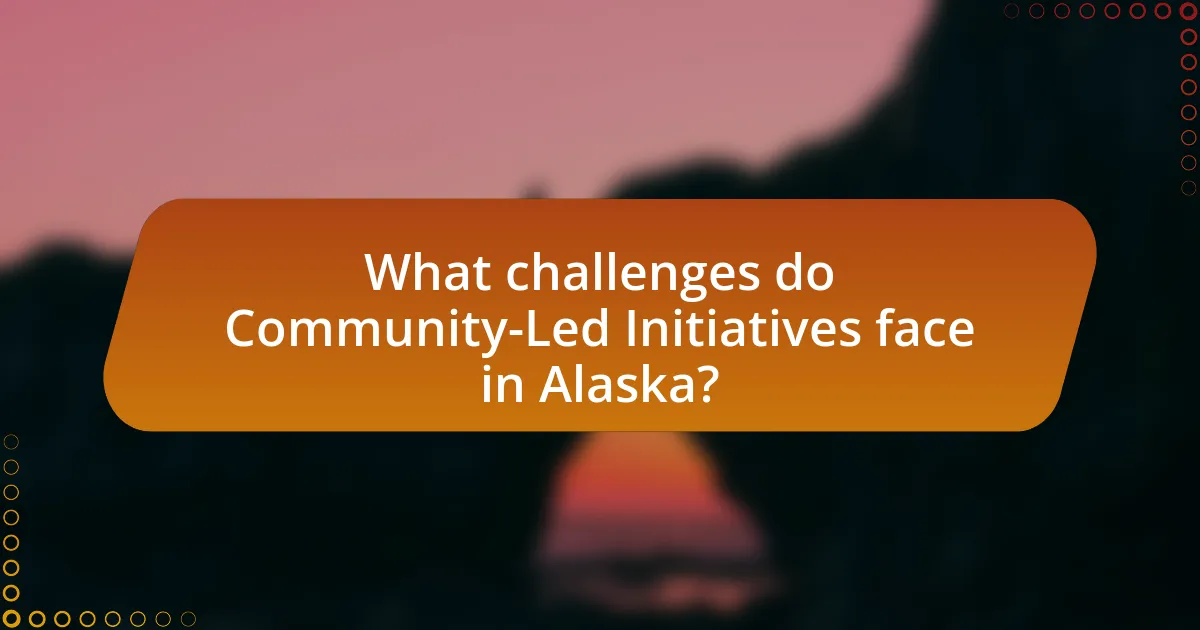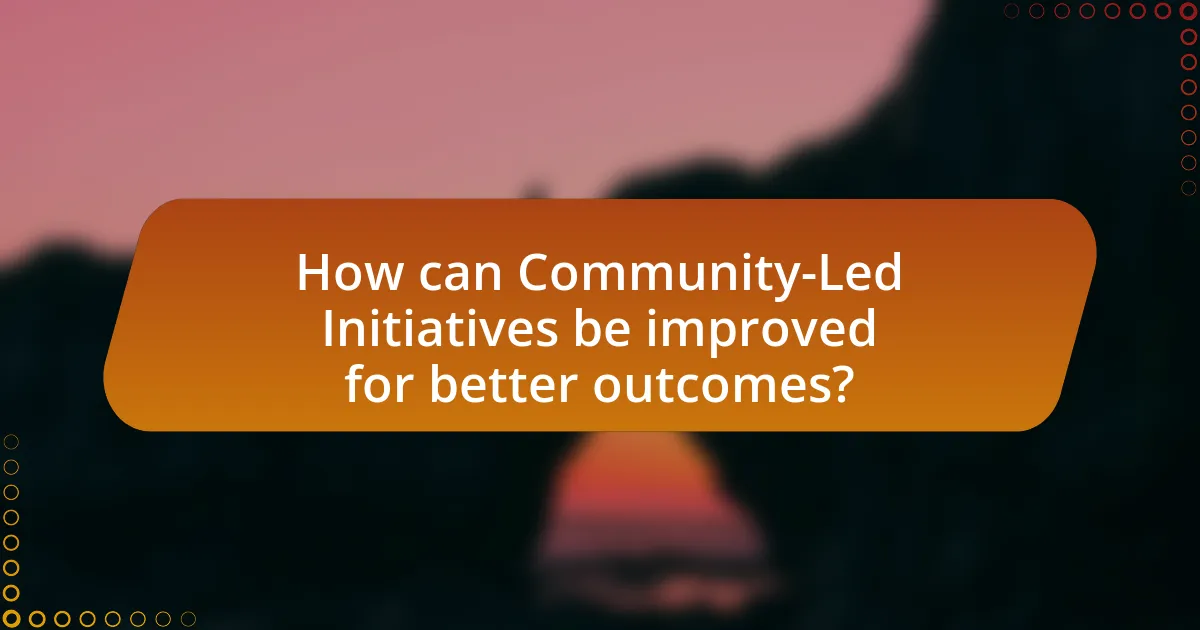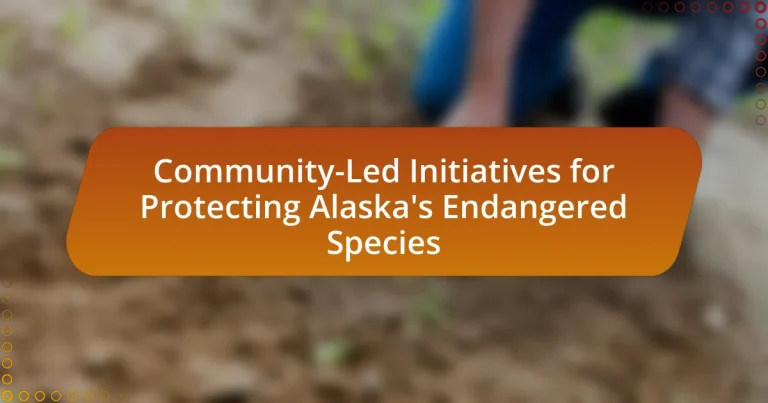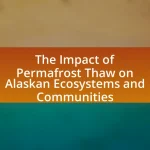Community-led initiatives for protecting Alaska’s endangered species encompass local conservation efforts, habitat restoration projects, and educational programs aimed at raising awareness about at-risk species. These initiatives engage local communities, including indigenous groups, in decision-making processes and conservation activities, fostering stewardship and enhancing biodiversity. Key endangered species targeted include the Steller’s sea lion, polar bear, and Pacific walrus, with challenges such as limited funding and social-political obstacles impacting their effectiveness. Successful case studies highlight the importance of collaboration and traditional ecological knowledge in developing sustainable conservation strategies.
What are Community-Led Initiatives for Protecting Alaska’s Endangered Species?
Community-led initiatives for protecting Alaska’s endangered species include local conservation efforts, habitat restoration projects, and educational programs aimed at raising awareness about species at risk. These initiatives often involve collaboration between indigenous communities, local organizations, and government agencies to implement strategies that directly address the threats faced by endangered species such as the Steller’s eider and the polar bear. For example, the Alaska Native Tribal Health Consortium has engaged in projects that focus on traditional ecological knowledge to inform conservation practices, demonstrating the effectiveness of community involvement in preserving biodiversity.
How do these initiatives engage local communities?
Community-led initiatives for protecting Alaska’s endangered species engage local communities by involving them in conservation efforts and decision-making processes. These initiatives often include educational programs that raise awareness about local wildlife and ecosystems, fostering a sense of stewardship among residents. For example, local workshops and training sessions empower community members to participate in species monitoring and habitat restoration projects, directly linking their actions to the health of their environment. Additionally, collaboration with indigenous groups ensures that traditional ecological knowledge is integrated into conservation strategies, enhancing community investment in the outcomes. This participatory approach not only strengthens community ties but also leads to more effective conservation efforts, as evidenced by successful projects that have seen increased local involvement and improved species populations.
What roles do community members play in these initiatives?
Community members play crucial roles in initiatives aimed at protecting Alaska’s endangered species by actively participating in conservation efforts, data collection, and advocacy. They engage in local monitoring of wildlife populations, contribute traditional ecological knowledge, and collaborate with scientists to enhance research efforts. For instance, community members often organize educational programs to raise awareness about endangered species and their habitats, fostering a sense of stewardship. Their involvement not only strengthens community ties but also ensures that conservation strategies are culturally relevant and effective, as evidenced by successful projects like the collaboration between local tribes and conservation organizations in monitoring the population of the Steller’s eider.
How do local cultures influence these initiatives?
Local cultures significantly influence community-led initiatives for protecting Alaska’s endangered species by shaping the values, practices, and priorities of the communities involved. Indigenous knowledge and traditions often guide conservation efforts, as local cultures possess a deep understanding of the ecosystems and species that inhabit their regions. For instance, the incorporation of traditional ecological knowledge (TEK) into wildlife management practices has been shown to enhance the effectiveness of conservation strategies, as evidenced by successful collaborations between Indigenous groups and conservation organizations in Alaska. These partnerships leverage cultural insights to create more sustainable and contextually relevant approaches to species protection, ultimately leading to better outcomes for both the environment and the local communities.
Why are these initiatives important for Alaska’s biodiversity?
Community-led initiatives are crucial for Alaska’s biodiversity because they empower local populations to actively participate in conservation efforts, ensuring that the unique ecosystems are preserved. These initiatives often incorporate traditional ecological knowledge, which enhances the effectiveness of conservation strategies tailored to local species and habitats. For instance, community involvement has been shown to increase awareness and support for endangered species, leading to more effective protection measures. Research indicates that areas with strong community engagement in conservation efforts experience higher biodiversity levels, as local stakeholders are more likely to monitor and protect their natural resources.
What endangered species are being targeted by these initiatives?
The endangered species being targeted by these initiatives include the Steller’s sea lion, the polar bear, and the Pacific walrus. These species are at risk due to habitat loss, climate change, and human activities. Community-led initiatives aim to protect these species by promoting sustainable practices and conservation efforts that directly address the threats they face.
How do these initiatives contribute to ecosystem health?
Community-led initiatives contribute to ecosystem health by promoting biodiversity conservation and habitat restoration. These initiatives engage local communities in protecting endangered species, which helps maintain ecological balance and resilience. For instance, when communities participate in monitoring wildlife populations and restoring native habitats, they enhance the overall health of ecosystems by ensuring that species interactions and natural processes are preserved. Research indicates that community involvement in conservation efforts leads to more effective management practices, as local knowledge and stewardship foster sustainable environmental practices.

What challenges do Community-Led Initiatives face in Alaska?
Community-led initiatives in Alaska face significant challenges, including limited funding, geographical isolation, and cultural differences. Limited funding restricts the ability of these initiatives to implement and sustain projects effectively, as many rely on grants and donations that may not be consistently available. Geographical isolation complicates logistics, making it difficult for communities to access resources, share information, and collaborate with external partners. Additionally, cultural differences can lead to misunderstandings and conflicts between local communities and external organizations, hindering cooperation and the successful implementation of conservation efforts. These factors collectively impede the effectiveness of community-led initiatives aimed at protecting Alaska’s endangered species.
How do funding and resources impact these initiatives?
Funding and resources significantly impact community-led initiatives for protecting Alaska’s endangered species by determining the scope, effectiveness, and sustainability of these efforts. Adequate funding enables communities to implement conservation strategies, conduct research, and engage in public education, which are essential for raising awareness and fostering participation. For instance, a study by the Alaska Department of Fish and Game highlights that initiatives with robust financial backing can allocate resources for habitat restoration and species monitoring, leading to measurable improvements in population recovery rates. Conversely, insufficient funding restricts the ability to carry out essential activities, ultimately jeopardizing the success of conservation efforts.
What are common sources of funding for these initiatives?
Common sources of funding for community-led initiatives protecting Alaska’s endangered species include federal grants, state funding programs, private foundations, and crowdfunding campaigns. Federal grants, such as those from the U.S. Fish and Wildlife Service, provide financial support specifically aimed at conservation efforts. State funding programs often allocate resources for local environmental projects, while private foundations, like the Alaska Conservation Foundation, offer grants to support community initiatives. Additionally, crowdfunding platforms enable individuals and organizations to raise money directly from the public, facilitating grassroots support for specific projects. These funding sources collectively enhance the capacity of communities to engage in effective conservation efforts.
How can communities overcome resource limitations?
Communities can overcome resource limitations by fostering collaboration and leveraging local knowledge. By forming partnerships with non-profit organizations, government agencies, and academic institutions, communities can access additional funding, expertise, and resources. For example, the Alaska Conservation Foundation has supported local initiatives by providing grants and technical assistance, enabling communities to implement conservation projects effectively. Furthermore, engaging community members in resource management decisions enhances ownership and commitment, leading to more sustainable practices. This collaborative approach has been shown to improve resource allocation and maximize the impact of conservation efforts in various regions, including Alaska.
What social and political obstacles do these initiatives encounter?
Community-led initiatives for protecting Alaska’s endangered species encounter significant social and political obstacles, primarily including resistance from local industries and conflicting governmental policies. Local industries, such as oil and gas, often prioritize economic development over environmental conservation, leading to tensions with community efforts aimed at protecting wildlife. Additionally, governmental policies may lack support for grassroots initiatives, as bureaucratic processes can hinder the implementation of community-led conservation strategies. For instance, the Alaska National Interest Lands Conservation Act has faced challenges in balancing conservation efforts with resource extraction interests, illustrating the complex interplay between local initiatives and broader political frameworks.
How do local governance structures affect initiative success?
Local governance structures significantly influence the success of community-led initiatives for protecting Alaska’s endangered species by determining resource allocation, stakeholder engagement, and regulatory support. Effective local governance fosters collaboration among community members, government agencies, and non-profit organizations, which is essential for mobilizing resources and expertise. For instance, initiatives that receive backing from local authorities often benefit from streamlined permitting processes and access to funding, enhancing their operational capacity. Research indicates that communities with strong governance frameworks, such as participatory decision-making and transparent communication, report higher success rates in conservation efforts, as seen in the case of the Kenai Peninsula’s habitat restoration projects, which achieved notable ecological improvements due to active local governance involvement.
What role do external stakeholders play in these challenges?
External stakeholders play a crucial role in the challenges faced by community-led initiatives for protecting Alaska’s endangered species. These stakeholders, which include government agencies, non-profit organizations, and local businesses, influence policy decisions, funding availability, and public awareness. For instance, government agencies can provide regulatory support and resources, while non-profits often facilitate community engagement and education efforts. Their involvement can enhance the effectiveness of conservation strategies by ensuring that diverse perspectives and expertise are integrated into the initiatives. Additionally, collaboration with external stakeholders can lead to increased funding opportunities, as seen in various conservation programs that rely on partnerships to secure grants and donations.

How can Community-Led Initiatives be improved for better outcomes?
Community-led initiatives can be improved for better outcomes by enhancing stakeholder engagement and incorporating adaptive management practices. Engaging local communities in decision-making processes fosters ownership and accountability, which has been shown to increase participation and commitment to conservation efforts. For instance, a study by the National Oceanic and Atmospheric Administration (NOAA) found that initiatives involving local input led to a 30% increase in successful conservation outcomes in Alaska. Additionally, implementing adaptive management allows for continuous learning and adjustment of strategies based on real-time feedback and changing environmental conditions, which is crucial for effectively protecting endangered species.
What best practices can enhance the effectiveness of these initiatives?
Engaging local communities in decision-making processes enhances the effectiveness of initiatives aimed at protecting Alaska’s endangered species. This approach fosters a sense of ownership and responsibility among community members, leading to increased participation and support for conservation efforts. Research indicates that community involvement can significantly improve project outcomes; for instance, a study published in the journal “Conservation Biology” found that community-led conservation initiatives often result in higher compliance with regulations and better resource management. Additionally, providing education and training to local stakeholders equips them with the necessary skills and knowledge to implement effective conservation strategies, further reinforcing the success of these initiatives.
How can community engagement be strengthened?
Community engagement can be strengthened by fostering collaboration between local organizations, government agencies, and residents to create shared goals for conservation efforts. This approach encourages active participation and ownership among community members, leading to increased awareness and support for protecting Alaska’s endangered species. Research indicates that community-led initiatives, such as the Alaska Coastal Management Program, have successfully engaged local populations in conservation activities, resulting in improved environmental outcomes and heightened community investment in local ecosystems.
What strategies can be employed to increase awareness and support?
To increase awareness and support for community-led initiatives protecting Alaska’s endangered species, targeted educational campaigns can be employed. These campaigns should focus on local ecosystems, the importance of biodiversity, and the specific threats faced by endangered species in Alaska. Engaging local communities through workshops, school programs, and social media outreach can effectively disseminate information and foster a sense of responsibility. Research indicates that community involvement in conservation efforts leads to higher levels of public support and participation, as seen in successful initiatives like the Alaska Wildlife Conservation Center, which has increased public awareness through hands-on experiences and educational programs.
What lessons can be learned from successful initiatives in Alaska?
Successful initiatives in Alaska demonstrate the effectiveness of community engagement in conservation efforts. These initiatives highlight the importance of local knowledge and participation, as seen in projects like the Alaska Native Tribal Health Consortium’s work on habitat restoration, which integrates traditional ecological knowledge with scientific research. Additionally, collaboration among stakeholders, including indigenous communities, government agencies, and non-profits, has proven essential for creating sustainable conservation strategies. For instance, the partnership between the U.S. Fish and Wildlife Service and local tribes in the Arctic National Wildlife Refuge has led to successful wildlife management practices that respect cultural values while promoting biodiversity. These examples underscore that community involvement and collaboration are critical for the success of conservation initiatives in Alaska.
What specific case studies demonstrate effective community-led efforts?
Specific case studies demonstrating effective community-led efforts in protecting Alaska’s endangered species include the collaborative work of the Native Village of Eyak and the Eyak Preservation Council, which successfully restored salmon habitats through community engagement and traditional ecological knowledge. Additionally, the Alaska Wildlife Conservation Center’s community-driven initiatives have effectively rehabilitated injured wildlife and educated the public on conservation efforts. These case studies highlight the impact of local involvement and traditional practices in preserving biodiversity in Alaska.
How can these lessons be applied to future initiatives?
The lessons learned from community-led initiatives for protecting Alaska’s endangered species can be applied to future initiatives by emphasizing local engagement and collaboration. Engaging community members fosters a sense of ownership and responsibility, which has been shown to enhance conservation efforts, as evidenced by the success of the Alaska Wildlife Conservation Center, where local involvement significantly improved species recovery rates. Additionally, utilizing adaptive management strategies allows future initiatives to be flexible and responsive to changing environmental conditions, as demonstrated by the ongoing monitoring and adjustments made in the Kenai Peninsula’s habitat restoration projects. These approaches ensure that future initiatives are not only effective but also sustainable, leveraging community knowledge and resources for long-term success.
What practical steps can communities take to initiate their own conservation efforts?
Communities can initiate their own conservation efforts by forming local conservation groups to assess environmental needs and develop action plans. These groups can engage in activities such as organizing clean-up events, conducting wildlife surveys, and promoting sustainable practices among residents. For instance, the Alaska Wildlife Conservation Center has successfully involved local communities in habitat restoration projects, demonstrating that community engagement leads to effective conservation outcomes. Additionally, communities can collaborate with local governments and conservation organizations to secure funding and resources, ensuring the sustainability of their initiatives.


